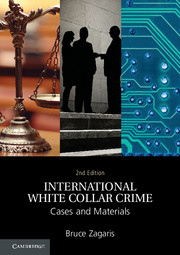Book contents
- Frontmatter
- Contents
- Preface
- 1 Introduction
- 2 Taxation
- 3 Money Laundering and Counterterrrorism Financial Enforcement
- 4 Transnational Corruption
- 5 Transnational Organized Crime
- 6 Export Control and Economic Sanctions
- 7 International Environmental Crimes
- 8 International Securities Enforcement
- 9 Extraterritorial Jurisdiction
- 10 International Evidence Gathering
- 11 Extradition and Alternatives
- 12 International Prisoner Transfer
- 13 The United Nations
- 14 The World Bank Group
- 15 INTERPOL
- 16 Economic Integration and Business Crimes
- Index
- References
7 - International Environmental Crimes
Published online by Cambridge University Press: 05 November 2015
- Frontmatter
- Contents
- Preface
- 1 Introduction
- 2 Taxation
- 3 Money Laundering and Counterterrrorism Financial Enforcement
- 4 Transnational Corruption
- 5 Transnational Organized Crime
- 6 Export Control and Economic Sanctions
- 7 International Environmental Crimes
- 8 International Securities Enforcement
- 9 Extraterritorial Jurisdiction
- 10 International Evidence Gathering
- 11 Extradition and Alternatives
- 12 International Prisoner Transfer
- 13 The United Nations
- 14 The World Bank Group
- 15 INTERPOL
- 16 Economic Integration and Business Crimes
- Index
- References
Summary
Introduction
This chapter discusses international instruments, principles, and theories applying criminal consequences to conduct that results in serious harm to vital or scarce natural resources, and the ways in which economic integration groups and countries, especially the United States, have enacted and enforcement criminal laws against international environmental crimes.
International environmental crime results from several causes.
(1) Differing values and costs occur when illegal activities arise from regulations that produce cost differentials between legal and illegal products, by differential compliance costs or different consumer prices, by demand in different countries for scarce products for which substitutes are either not available or accepted, and by indifference to the environment.
(2) Regulatory breakdown occurs when illegal activities result from a deficiency of appropriate regulation, including failures to determine and/or protect property rights.
(3) Enforcement failure occurs when illegal activities arise from enforcement problems, such as suitability of regulations, the costs of compliance (e.g., detection of environmental contraband may be difficult), lack of resources and expertise, corruption, and political and economic disruption.
Transnational environmental crimes can be classified in two broad categories: anthropocentric and bio- or ecocentric. The first category focuses on the human environment, or the elements of nature directly concerning human survival and welfare. The second category concerns the entire natural environment, without regard to whether the environmental element in question relates to human life.
Trade liberalization and deregulation make enforcing border controls more difficult. The rise of transnational organized crime and the growth of transnational environmental crime in developing countries, which lack capacity, political will, governance, and institutional frameworks to properly implement environmental enforcement, all contribute to the increase of transnational environmental crime.
Policies to combat international environmental crime include: controlling the illegal trade, including enhanced cooperation between environment and enforcement agencies at the international, regional, and national levels; the establishment of national environmental crime units or working parties; and improved means of tracking and identifying illegal products.
- Type
- Chapter
- Information
- International White Collar CrimeCases and Materials, pp. 252 - 282Publisher: Cambridge University PressPrint publication year: 2015

